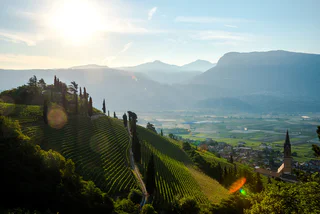
Kurtatsch/Cortaccio – Penon/Penone - Kurtatsch/Cortaccio
Magrè s.S.d.V./Margreid a.d.W., Margreid an der Weinstraße/Magrè sulla Strada del Vino, Alto Adige Wine Road
Lace your hiking boots and start exploring the landscape along the Alto Adige Wine Road. By hitting one of these trails, you'll walk on winding paths, through picturesque vineyards and from quaint villages up to sweeping views. Whether you're looking for a leisurely or challenging trail, there are all difficulty levels. On the Alto Adige Wine Road you can experience the perfect blend between nature and culture, taste local wines at modern wineries, and enjoy the flair of an Alpine-Mediterranean atmosphere.

Magrè s.S.d.V./Margreid a.d.W., Margreid an der Weinstraße/Magrè sulla Strada del Vino, Alto Adige Wine Road

1/2
Tramin an der Weinstraße/Termeno sulla Strada del Vino, Alto Adige Wine Road

1/2
Cortaccia s.S.d.V./Kurtatsch, Kurtatsch an der Weinstraße/Cortaccia sulla Strada del Vino, Alto Adige Wine Road

1/12
Caldaro Paese/Kaltern Dorf, Kaltern an der Weinstraße/Caldaro sulla Strada del Vino, Alto Adige Wine Road

Sella/Söll, Tramin an der Weinstraße/Termeno sulla Strada del Vino, Alto Adige Wine Road

1/6
Mazzon/Mazon, Neumarkt/Egna, Alto Adige Wine Road

1/8
Caldaro Campi al lago/Kalterer Klughammer, Kaltern an der Weinstraße/Caldaro sulla Strada del Vino, Alto Adige Wine Road

Tramin an der Weinstraße/Termeno sulla Strada del Vino, Alto Adige Wine Road

Terlano/Terlan, Terlan/Terlano, Alto Adige Wine Road

Salorno/Salurn, Alto Adige Wine Road

1/3
Tramin an der Weinstraße/Termeno sulla Strada del Vino, Alto Adige Wine Road

1/14
Laghetti/Laag, Neumarkt/Egna, Alto Adige Wine Road

Magrè s.S.d.V./Margreid a.d.W., Margreid an der Weinstraße/Magrè sulla Strada del Vino, Alto Adige Wine Road

1/3
St. Josef am See/S. Giuseppe al Lago, Kaltern an der Weinstraße/Caldaro sulla Strada del Vino, Alto Adige Wine Road

1/4
Salorno/Salurn, Alto Adige Wine Road

1/10
Monticolo/Montiggl, Eppan an der Weinstaße/Appiano sulla Strada del Vino, Alto Adige Wine Road

1/4
Castelvecchio/Altenburg, Kaltern an der Weinstraße/Caldaro sulla Strada del Vino, Alto Adige Wine Road

1/4
Oberplanitzing/Pianizza di Sopra, Kaltern an der Weinstraße/Caldaro sulla Strada del Vino, Alto Adige Wine Road

1/3
Andriano/Andrian, Andrian/Andriano, Alto Adige Wine Road

Sella/Söll, Tramin an der Weinstraße/Termeno sulla Strada del Vino, Alto Adige Wine Road

Terlano/Terlan, Terlan/Terlano, Alto Adige Wine Road

1/2
Barleit-Lavardi/Barleit-Lavardi, Kaltern an der Weinstraße/Caldaro sulla Strada del Vino, Alto Adige Wine Road

1/5
Terlano/Terlan, Terlan/Terlano, Alto Adige Wine Road

Cortina s.s.d.V./Kurtinig, Kurtinig an der Weinstraße/Cortina sulla Strada del Vino, Alto Adige Wine Road

1/4
S. Michele/St. Michael - Appiano/Eppan, Eppan an der Weinstaße/Appiano sulla Strada del Vino, Alto Adige Wine Road

1/5
Gand/Ganda - Eppan/Appiano, Eppan an der Weinstaße/Appiano sulla Strada del Vino, Alto Adige Wine Road

1/4
Mazzon/Mazon, Neumarkt/Egna, Alto Adige Wine Road

1/2
Obereggen/Obereggen, Deutschnofen/Nova Ponente, Alto Adige Wine Road

1/3
S. Michele/St. Michael - Appiano/Eppan, Eppan an der Weinstaße/Appiano sulla Strada del Vino, Alto Adige Wine Road

Cornaiano/Girlan, Eppan an der Weinstaße/Appiano sulla Strada del Vino, Alto Adige Wine Road